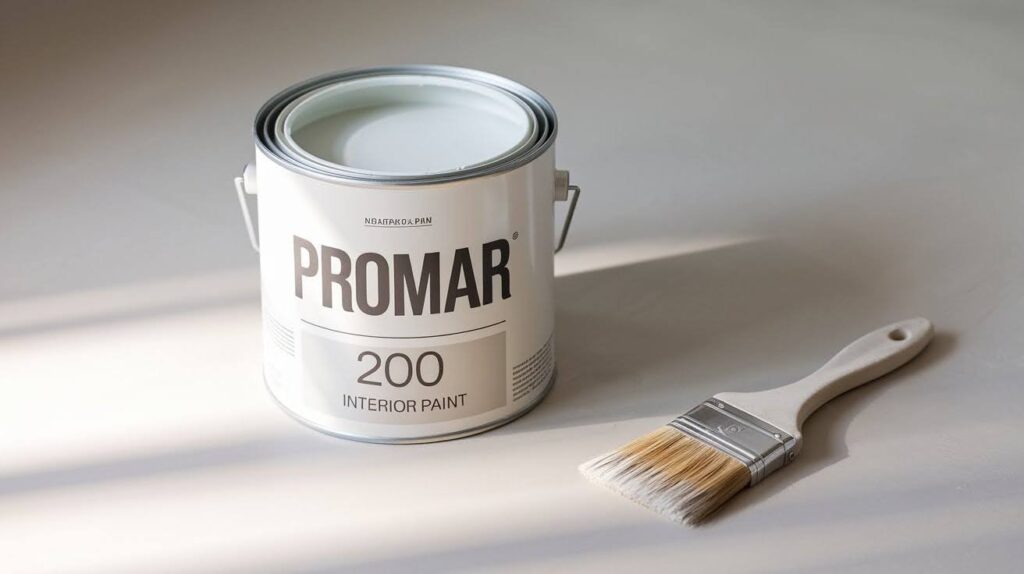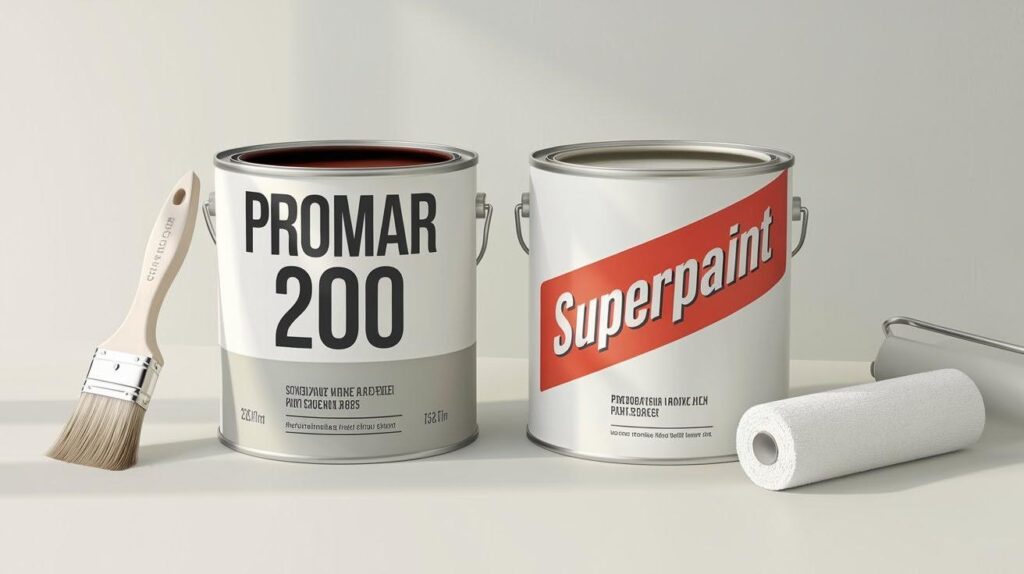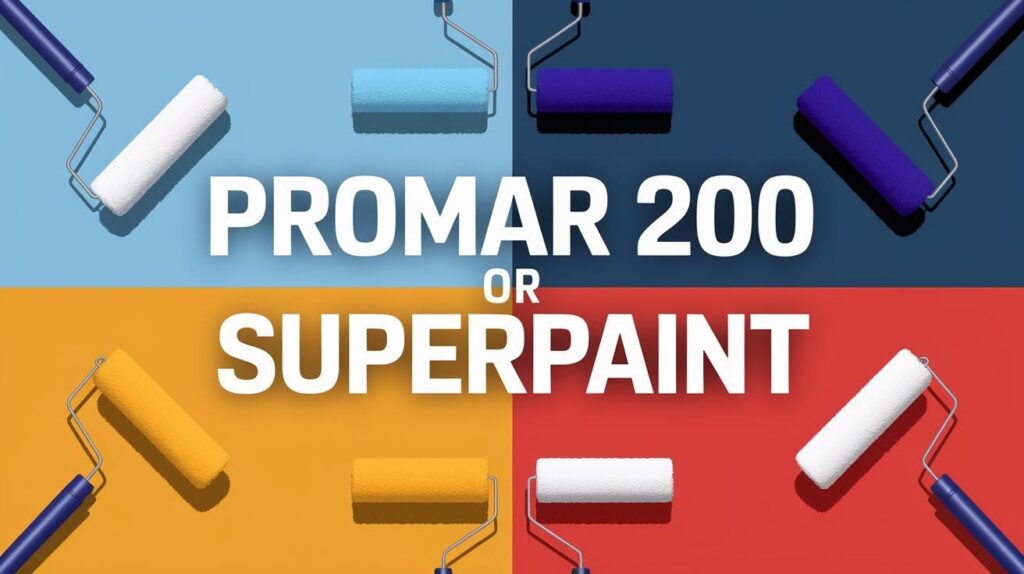When you’re standing in the paint aisle, staring at endless options, choosing the right interior paint can feel overwhelming. I get it, I’ve been there too, trying to figure out which paint will give me the best results without breaking the bank. That’s exactly why I’m diving deep into the ProMar 200 vs SuperPaint debate today.
These two Sherwin-Williams favorites keep coming up in every painting conversation, and for good reason. But here’s the thing, they’re designed for different needs, and picking the wrong one can leave you frustrated with the results. I’ve spent time researching, testing, and talking to both homeowners and painting professionals to bring you the real scoop.
Trust me, by the end of this comparison, you’ll know exactly which paint fits your project and budget. Let’s settle this once and for all.
ProMar 200 vs SuperPaint: Quick Comparison
Here’s a side-by-side breakdown of how these two popular Sherwin-Williams paints stack up across the features that matter most to your painting project.
| Feature | ProMar 200 | SuperPaint |
| Price | Budget friendly | Mid-range premium |
| Coverage | Good (350-400 sq ft/gallon) | Excellent (400-450 sq ft/gallon) |
| Durability | Basic, 3-5 years | High, 8-10 years |
| Finish Options | Limited (flat, eggshell, satin) | Full range (flat to semi-gloss) |
| VOC Content | Higher VOCs | Low VOC formula |
| Application | Standard flow | Self priming, easier application |
| Washability | Fair | Excellent scrub resistance |
| Best For | Rental properties, tight budgets | Family homes, high traffic areas |
| Professional Use | Basic commercial projects | Premium residential/commercial |
| Warranty | Limited | Extended manufacturer warranty |
Bottom Line: ProMar 200 gets the job done affordably, while SuperPaint offers premium performance and longevity.
What Is ProMar 200?

ProMar 200 is Sherwin-Williams’ budget friendly interior paint that gets the job done without emptying your wallet.
Let me tell you about ProMar 200 from my experience. It’s basically the workhorse paint that contractors reach for when they need decent coverage at a reasonable price.
I’ve used this paint in several projects. The first thing you’ll notice? It’s not fancy. But here’s what matters.
ProMar 200 delivers solid coverage on most surfaces. You’re looking at around 350 to 400 square feet per gallon. Not bad for a budget option.
The durability is what I call “good enough.” You’ll get about 3 to 5 years before you start seeing wear in high traffic areas. For guest rooms or low use spaces? It holds up just fine.
Now, the finish options are limited. You get flat, eggshell, and satin. That’s it. No semi gloss here.
One thing I noticed during the application. The flow isn’t as smooth as premium paints. You might need an extra coat for even coverage, especially over darker colors.
The price point makes it popular with landlords and budget conscious homeowners. I get why. When you’re painting multiple rental units, every dollar counts.
Is it perfect? Nope. But it’s honest paint that does what it promises without breaking your budget.
What Is SuperPaint?

SuperPaint is Sherwin-Williams’ premium interior paint that combines durability, coverage, and ease of application in one can.
I’ve painted with SuperPaint countless times, and honestly? It feels different from the moment you open the can.
The consistency is smoother. The coverage is better. You’re getting around 400 to 450 square feet per gallon, which means fewer trips to the store.
Here’s what really caught my attention during my first SuperPaint project. It’s self-priming on most surfaces. That saves you time and money right there.
The durability impressed me most. We’re talking 8 to 10 years of solid performance, even in busy hallways and kids’ rooms. I’ve seen SuperPaint jobs that still look fresh after five years of family life.
You get the full range of finishes, too. Flat, eggshell, satin, and semi-gloss. Whatever look you’re after, SuperPaint delivers.
The application? Buttery smooth. It flows off the brush or roller without fighting you. Less work for better results.
But here’s the thing that sealed it for me. The washability is outstanding. Crayon marks, scuff marks, and everyday life stuff wipe right off without damaging the finish.
Yes, it costs more upfront. But when you factor in the longevity and performance? SuperPaint often pays for itself through fewer repaints and touch ups over time.
It’s what I reach for when the project matters.
Coverage & Application: How Many Coats Do You Need?

The number of coats you’ll need depends on which paint you choose and what surface you’re covering.
ProMar 200 Coverage
I’ll be straight with you about ProMar 200. You’re probably looking at two coats minimum for most projects.
Over white or light colors? Sometimes one coat works. But that’s rare in my experience.
Here’s what I’ve learned from using ProMar 200. The coverage is decent but not spectacular. You get around 350 to 400 square feet per gallon under ideal conditions.
Going from dark to light? Plan on three coats. Maybe even a primer first.
The paint doesn’t hide imperfections as well, either. Small nail holes and minor wall flaws show through more easily than with premium paints.
Application feels thinner too. It’s workable, but you’ll notice the difference if you’ve used higher end paints before.
SuperPaint Coverage
Now this is where SuperPaint shines. One coat coverage is actually achievable in many situations.
I’ve covered beige walls with white SuperPaint in a single coat. The hiding power is that good.
SuperPaint gives you 400 to 450 square feet per gallon. But more importantly, that coverage is more consistent and thorough.
The self-priming feature makes a huge difference. You’re often done in one coat when you’d need two with other paints.
Even dramatic color changes work better. I’ve gone from deep red to light gray with just two SuperPaint coats.
The application feels rich and substantial. It flows smoothly and covers evenly without the streaky look you sometimes get with budget paints.
Bottom line? SuperPaint saves you time and often saves you paint too.
Best Use Cases: Where Should You Use Each Paint?

Knowing where to use each paint can save you money and headaches down the road.
ProMar 200 works best in low traffic areas where budget matters most. Think guest bedrooms, closets, or storage rooms.
I’ve used it successfully in rental properties. Landlords love the price point when they’re painting multiple units. It looks decent and keeps costs down.
Basements are another good spot. The lower humidity and foot traffic mean ProMar 200’s basic durability holds up fine.
But here’s where I wouldn’t use it. Skip ProMar 200 in kitchens, bathrooms, or kids’ rooms. The washability just isn’t there for messy, high use spaces.
Now SuperPaint? This is your go to for the rooms that matter.
Living rooms, bedrooms, hallways all benefit from SuperPaint’s durability. I’ve seen it handle years of family life without looking tired.
Kitchens and bathrooms are where SuperPaint really shines. The scrubbable finish handles splashes and steam like a champ.
Kids’ rooms? Absolutely SuperPaint. Crayon marks wipe off easily without damaging the paint film.
High-traffic hallways and stairwells get my SuperPaint recommendation too. The extra durability pays off when people are constantly brushing against walls.
Here’s my rule of thumb. Use ProMar 200 where you paint to refresh. Use SuperPaint where you paint to last.
The price difference makes sense when you think about it that way.
Comparison Table: ProMar 200 vs SuperPaint
Here’s everything you need to know about these two paints broken down into the factors that actually matter for your project.
| Factor | ProMar 200 | SuperPaint |
| Price per Gallon | $45-55 | $65-75 |
| Coverage | 350-400 sq ft | 400-450 sq ft |
| Coats Needed | Usually 2-3 | Often just 1-2 |
| Finish Options | Flat, eggshell, satin | Full range (flat to semi gloss) |
| Durability | 3-5 years | 8-10 years |
| Washability | Fair | Excellent |
| Self Priming | No | Yes |
| Application Feel | Standard flow | Smooth, easy spread |
| VOC Content | Higher | Low VOC |
| Best Room Types | Guest rooms, closets | Living areas, kitchens |
| Professional Use | Basic commercial | Premium residential |
| Hide Imperfections | Fair | Excellent |
The Real Cost Breakdown: While SuperPaint costs more upfront, you often use less paint due to better coverage. Factor in the longer lifespan, and SuperPaint frequently wins on total cost over time.
My Take: ProMar 200 gets you painted affordably. SuperPaint gets you painted right. Choose based on how long you want the job to last and how much traffic the room sees.
Tips for Choosing Between ProMar 200 and SuperPaint
Budget-Focused Decisions:
- Choose ProMar 200 if you need to paint multiple rooms on a tight budget
- Pick SuperPaint when you can invest more upfront for long term savings
- Remember SuperPaint often needs fewer coats, reducing total paint costs
Room-Based Selection:
- Use ProMar 200 in guest bedrooms, closets, and low traffic spaces
- Go with SuperPaint for kitchens, bathrooms, and kids’ rooms
- Choose SuperPaint for hallways and high touch areas
Project Timeline Considerations:
- Pick ProMar 200 when you have extra time for multiple coats
- Choose SuperPaint for quick weekend projects with one coat coverage
- SuperPaint saves prep time with its self priming feature
Durability Needs:
- Use ProMar 200 for spaces you plan to repaint in 3-5 years
- Choose SuperPaint where you want 8-10 years without touch ups
- Pick SuperPaint if you have kids or pets
Application Preferences:
- Go with ProMar 200 if you’re comfortable with basic paint flow
- Choose SuperPaint for easier, smoother application
- Pick SuperPaint if you want excellent washability
Professional vs DIY:
- ProMar 200 works for basic rental property updates
- SuperPaint suits homeowners wanting premium results
- Choose SuperPaint for client work requiring quality finishes
Conclusion
Choosing between ProMar 200 and SuperPaint really comes down to your specific project needs and budget. If you’re painting low traffic areas or working with tight financial constraints, ProMar 200 delivers solid results without breaking the bank. It’s honest paint that gets the job done.
But for rooms that see daily life, SuperPaint is worth every extra dollar. The superior coverage, durability, and washability make it the smarter long term investment for most homeowners.
My final recommendation? Use ProMar 200 where you paint to refresh and SuperPaint where you paint to last. Consider your timeline, budget, and how long you want the finish to look great. Both paints have their place in a smart painting strategy.
Frequently Asked Questions
Is ProMar 200 Good Quality Paint?
ProMar 200 offers decent quality for its price point, delivering solid coverage and basic durability. It’s perfect for budget conscious projects where you need reliable results without premium features.
How Long Does SuperPaint Last Compared to ProMar 200?
SuperPaint typically lasts 8-10 years with proper application, while ProMar 200 gives you 3-5 years of good performance. The longer lifespan often makes SuperPaint more cost effective over time.
Can I Use ProMar 200 in High Traffic Areas?
I wouldn’t recommend ProMar 200 for high traffic spaces like hallways or kids’ rooms. Its washability and durability aren’t designed to handle constant wear and cleaning.
Does SuperPaint Really Cover in One Coat?
SuperPaint often covers in one coat when going from light to light colors or using its self priming properties. Dramatic color changes or dark to light transitions may still require two coats.
Which Paint Is Better for Rental Properties?
ProMar 200 is popular with landlords due to its affordable price and acceptable performance. However, SuperPaint might save money long term if you factor in less frequent repainting and better tenant satisfaction.

